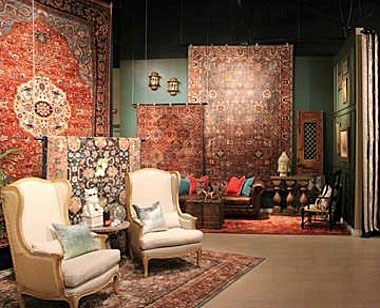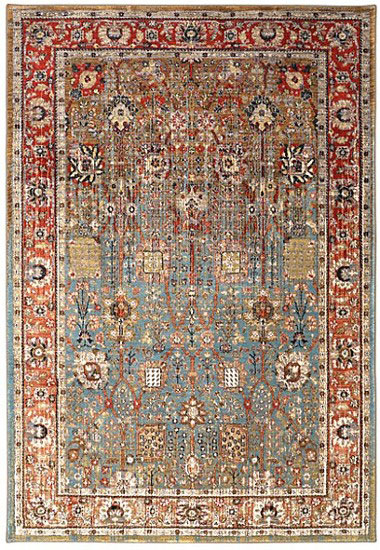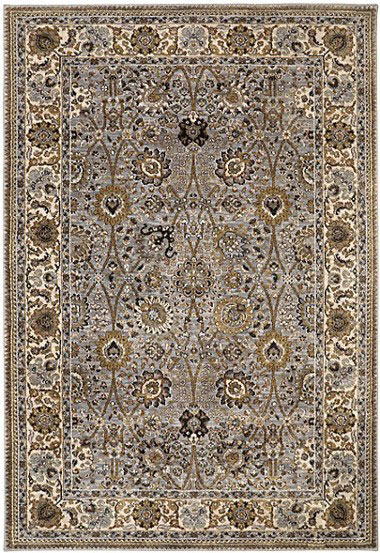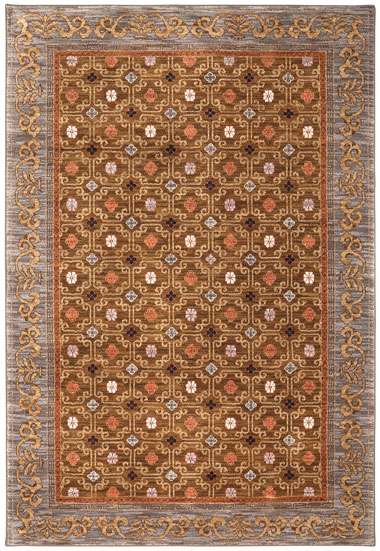|
WHY ARE 'SPICE MARKET' RUGS SO HOT?
Q&A with Karastan's Brandon Culpepper
|

Introduced at summer markets, Karastan's
Spice Market collection was prominently displayed at the
company's Las Vegas showroom. Retail on the
made-in-the-U.S.A. rugs is $399 in 5x8.
|
|
Typically at trade shows,
editors are the ones asking the questions. But at Las Vegas Market the
roles reversed when retailers and vendors began querying RugNews.com
about Karastan's new Spice Market collection. Why did a machine-woven
line of 20 rugs engender such a response from buyers and competitors?
Read our Q&A with Brandon Culpepper, VP Specialty Sales for Mohawk
Home and Karastan Rugs for the the backstory behind the buzz.
RugNews.com: In Las Vegas,
we heard Spice Market was 'on fire'. Why do you think that is?
Culpepper:
That's great to hear, and
very flattering. The market loved Spice Market because it is a
beautiful, traditional line that looks like the old Karastan Axminsters.
The colors are warm, but fashion-forward. It's a real breakthrough:
Spice Market is made on cutting edge Van De Weile looms with EverStrand
[recycled PET polyester], but customers tell us the rugs are truly
worthy of the Karastan label.
|
"Spice Market is
a high tech rug that looks handmade. It's the total package in
machine-made rugs." - Brandon Culpepper
|

|
RugNews.com: What about
price - wasn't $399 in 5x8 a big factor?
Culpepper:
The price is almost unbelievable when you see it and feel it. The rugs
are visually gorgeous, soft to the touch and I think it is an amazing
value. It's the total package in machine made rugs. Spice Market is a
high tech rug that looks handmade: rich, beautiful and timeless.
RugNews.com: How did you
pull that off?
Culpepper:
It's been a labor of love for Tracy Pruitt, who is our VP of design.
He's been working hard to come up with an EverStrand product that was
built off our yarn system but looked like Karastan. The yarn is space
dyed and it was a tough balancing act to pull that off.
|

The globally-inspired Myanmar in Aquamarine was
the number one best-seller in Karastan's Spice Market collection
introduced at Atlanta and Las Vegas Markets.
|
RugNews.com: What makes the
colors and designs different from previous Karastan EverStrand lines?
Culpepper:
We're using the beautiful design elements and warmer colors that people
associate with Karastan. EverStrand has a color bank of 10 colors. The
yarn is space dyed, so each color has three shades. It's tough working
with 30 shades of color. We're using a two-color change-out when
weaving: we stop, take two colors down and put up two new. Across the
entire spectrum there are 36 colors in Spice Market.
RugNews.com: Is Spice
Market proof that traditional is coming back?
Culpepper:
Traditional never went
anywhere. The rug business left it, and that was a folly. Traditional is
the heart of the rug market and always will be. Why go chasing trends?
Frets are easy; ikats are easy; my daughter can draw a chevron on the
back of her notebook. But to do a beautiful Agra or Kashan design that
looks like the real thing? That is not easily done. It involves a huge
investment in artistic time and ability.
RugNews.com: How long has
Spice Market been in the works?
Culpepper:
Each design was carefully selected because we wanted Spice Market to
become a franchise for Karastan. It took two years to get all 20
designs approved.
|

At
Karastan, the Aden design in silver was the Spice Market
collection's number two best-seller with a combination of
neutral silver colorway and a classic motif.
|
RugNews.com: Were you
after a specific demographic, perhaps an older consumer?
Culpepper:
No. And that kind of underscores our belief that traditional is not a
niche market, but it is the heart of the market. Spice Market appealed
to everyone from the millennial product manager to the e-commerce
retailer to a buyer at Macy's. It sold in Atlanta; it sold in Vegas.
Sales were not regional: it sold in the east and the west; north and
south.
RugNews.com: Why do you
think Spice Market sold across demographic lines?
Culpepper:
Again, I don't think traditional people ever went anywhere. The key
is: can you design traditional in the right colors? Do you invest in the
product development to get the right looks? Can you do it at the right
price and also do it with speed to market? The definition of
traditional is so broad now. It could be a busy Persian design or a
relaxed traditional. Spice Market is more relaxed traditional, leaning
more toward transitional. The yarn is recycled PET from plastic bottles,
so it also has a green story.
RugNews.com: Can you tell
us best sellers at summer markets?
Culpepper: The number
one best seller in Spice Market was Myanmar in aquamarine and the number
two was Aden in silver. What sells rugs is color. Color is what is
driving Spice Market now.
RugNews.com: What retail
channels are you targeting for Spice Market?
Culpepper:
Furniture retailers, flooring retailers and rug retailers.
RugNews.com: When will
Spice Market be in stores?
Culpepper:
We announced a big
initiative in Atlanta this summer that focuses on speed to market. We
will ship in the same season we launch a collection, so Spice Market
launched in July and will ship to in September so the newness will hit
quickly.
|

In
the distinctive Palmyra Tobacco from the Spice Market
Collection, quatrefoils in jewel tones create a contemporary
checkerboard framed with scrollwork.
|
08.18.15
|